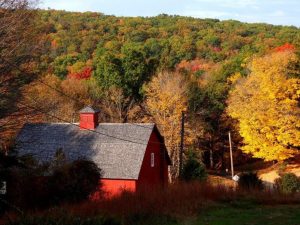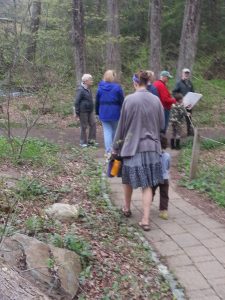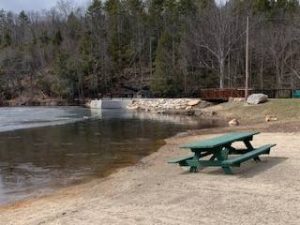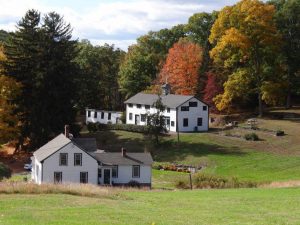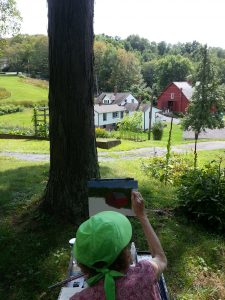The Valley Falls area has benefited over the years because local residents of Vernon cared to be as protective of the natural beauty and resources found here as was Mary Batterson Beach, the matriarch of the Beach family who owned the park and farm land from 1915-1958. After her death, Mary’s son, Charles, sold the land to an Essex land-development company, Jones and Lyon, in 1958. Residents of the Vernon Fire District, many of them volunteer firemen with families, who had held various drills and practices there at the invitation of Charles Beach, voted to impose a tax on themselves in order to purchase 130 acres of the undevelopable land–including the pond–to preserve it from future development, and to “provide something for the future” in 1963. The purchase price was $32,000. When the Vernon Fire District and the City of Rockville consolidated to form the Town of Vernon in 1964, the area came under the Town of Vernon Government auspices. Jones and Lyon donated an additional 63 acre parcel of remaining land to the Town of Vernon in 1972, to form the current Valley Falls Park area, approximately 193 acres. (“History of Valley Falls Park,” Ron Burke, circa 2002)
The Friends of Valley Falls (FVF) was loosely organized in 1972 when Ginny Gingras and six other women began giving “nature walks” at the Park, and met weekly to compare notes and share recent discoveries. In 1977, Mary Ellen Linderman, recreation commissioner, asked the group to become an advisory body to her department and to monitor ongoing conditions at the Park. Their goal was always to advocate for responsible stewardship of the resource that was becoming Valley Falls Park. In the 80’s and 90’s, the group coordinated with Vernon’s Director of Parks and Recreation, Bruce Dinnie, to sponsor environmental education programs in the Park, and lend expertise with maintenance and enhancement of the resources available to an increasing population taking advantage of the Park’s varied offerings, such as hiking trails, swimming and fishing opportunities at the pond, and enjoyment of the natural biodiversity of the place. (FVF Newsletter, 1981)
In 1980, a Board of Directors consisting of seven members was selected. The group decided to incorporate, followed by the creation of a constitution and by-laws (1993). As the group formalized, and expanded their advocacy, it became apparent that the historic Red Barn that anchored the park needed help to survive. A renewed application for 501 C-3 status was undertaken to find and build funding sources for a barn restoration. Formal membership drives had been in place earlier, but the momentum and necessity of saving the Red Barn created an urgency and spurred growth in membership.
A monetary donation in recognition of FVF efforts to protect the Park’s resources and initiate the renovation of the 100 (plus)-year-old deteriorating Red Barn for its future use as a nature education center set in motion Phase I of FVF’s effort to renovate the barn. Under advocacy spearheaded by neighbor and “Special Projects Coordinator,” Carol Burke, 139 members and contributors raised $6,000! Carol remembers that “the metal stanchions that once identified each cow’s space in the basement of the barn were only twisted pieces of metal leaning in various directions. Slabs of concrete flooring projected upward and sideways in every direction! Nothing had been done to maintain the barn in decades.” Local architect, and Vice President of FVF, Dan Wright, developed a master plan and architectural drawings for the renovation. The Vernon Town Council, under Mayor Tony Muro, was persuaded to approve the use of Local Capital Improvement (LoCIP) grant money to help fund the restoration. Local contractor, Rashid Hamid, of Naek Construction Co, offered to “remove the broken concrete floor, replace and re-position the structural supports so the intended meeting area will be free of obstructions, and re-pour a new concrete floor” in the collapsing lower level, at his cost of $16,000. (FVF Newsletters, Spring, 1995 and 1996)
Years of hard work followed; many visits by Mr Hamid and his crew, so many volunteer hands–painting, residing, installation of windows and new doors, hundreds of hours given to the cause. Mr Hamid also stepped in to finish the back wall (south) with windows, since no funds had been set aside to close in that area. In a March 6, 1999 letter to Mayor Muro and the Town Council members, Mr Hamid wrote “Naek Construction Company wants to see the barn restored to a state which will encourage rather than discourage its use, and to join other individuals and businesses which have volunteered time and service for this very worthy project.” Carol Burke recalls “Rashid knew instinctively after his first visit what would be needed to secure the structural integrity of the barn. Many thanks for his civic-mindedness and foresight!”
In May of 1995, FVF’s 501 C-3 non-profit status was re-approved, and the restoration proceeded. All of this effort on the part of FVF was to aid in obtaining grants, funding and legitimacy toward future endeavors on behalf of Valley Falls Park. Membership in FVF increased to 189 families and individuals.
In 1997, a berm was constructed by the Vernon Public Works Department on the east side of the barn to prevent yearly spring flooding of the basement floor. In 2003, curtain drains were installed and brush cleared by town employees, uncovering a stone cistern. In 2002, FVF did a great deal of research, led by Ann Letendre, that produced a beautiful new 50-year roof for the barn; a new coat of paint was applied in 2006. A split rail fence was added in 2016. Co-ordination between Parks and Rec Director Marty Sitler and FVF led to a new well, septic and ADA-accessible bathroom facilities added in 2018, along with parking lot renovations. The Red Barn is now a safe, dry, stable and beautifully refurbished example of a 19th century Gambrel-roof New England Bank Barn. The upper floor retains its original features.
In 2023, the Friends secured funding to evaluate the structural integrity of the Red Barn. Cirrus Structural Engineering of Columbia found significant cracks in several beams and recommended temporary repairs so that the roof could handle NE winter snow loads. A temporary “fix” would involve installing come-alongs from eave to eave at the base of each truss. To the rescue came Northford Timber Framers (www.northfordtimberframers.com)! Vernon Town Engineer, Dave Smith, coordinated a team that spent a chilly December day installing the gears and cables needed to stabilize the structure. In 2024, the Vernon Town Council approved $25,000 to permanently repair the beams. The money was appropriated from the Town’s American Rescue Plan Act (ARPA) funding. FVF has an agreement with the Town to use the 1911 barn for annual meetings and as a “Welcome Center” for Heritage Center activities. The Red Barn now includes historic farm exhibits, a restroom, and parking area. A very productive FVF/Town of Vernon partnership!
History of the Braille Trail at Valley Falls Park
The Multi-Access Trail at Valley Falls Park, as it exists today, is a shining example of volunteerism in the Town of Vernon. Also known as “The Braille Trail,” it was developed over time through three major efforts. The 1/4 mile easy walk alongside a babbling brook has become a destination for handicapped people of all ages and abilities to enjoy nature in the Park.
The initial idea and first installation was the brainchild of Brad Stewart, an Eagle Scout from Vernon Troop 223. In 1996, he approached the Friends of Valley Falls and the Vernon Parks & Recreation Director, Bruce Dinnie, to support his Eagle Scout project to create a walking path for the visually impaired. He planned the trail to be located in the flat area between Railroad Brook and Valley Falls Road, near the Park entrance. The project received enthusiastic support from all parties, and thus began a remarkable collaboration that created this unique facility in the Park.
Led by Stewart, the project proceeded. Members of Troop 223, and about 10 parents and volunteers cleared a path for the walking trail, and installed the posts, roping and signs. Friends members, Carol Burke and Paul and Ginny Gingras assisted with fabrication of the signage. Text for the Braille signage was provided by Oak Hill School for the Blind. George Arthur constructed a bridge over a gully and tree roots. Parks and Recreation Department employees, Dave Bower, Mark Lucas, and Mitch Reid constructed an accessible walkway from the parking lot down the slope to the walking trail.
The second project development effort was initiated in 2000. Improvements were needed for the access trail down the slope. The Parks and Recreation Department received a $4,600 grant to extend the Braille Trail and to address the steep slope problem. Volunteer work was led by Eagle Scout Dan Kinsman of Troup 223 and Will Boutwell, Troup 11. Their project also focused on exposing buried historical elements along sections of the Braille Trail. One area was the site of the first mill in Vernon. Another area on the access path down the slope was the site of a 1920’s swimming pool installed by the Charles Beach family, a prominent Hartford family, who owned the property from 1915-1958 and had a summer home on Bolton Road. Over time, these structures had become covered with vegetation and debris.
The scouts uncovered the original Beach pathways and a stone patio, and cleared the 3-bay charcoal filtering system for the Beachs’ pool. With the help of Mark Lucas, the stone patio area was improved and a bench was placed at the site; Scouts Tim Callahan and Will Boutwell cleared brush and helped to uncover old mill ruins.
By 2009, the Braille Trail needed a major overhaul. The original wooden Braille signs were experiencing weather rot. The stonedust access pathway down the steep slope to the trail site was prone to continuous erosion, thus creating a dangerous situation. The Friends of Valley Falls decided to take on the project. Led by Ann Letendre, they applied for a grant for $40,800 from the Recreational Trails Program through the CT Department of Environmental Protection. The grant required $10,200 of matching funds. The grant was awarded, thus providing for a total investment of $51,000 in improvements to the Braille Trail.
Using grant funds, the Friends contracted for the fabrication of 17 metal Braille signs (Sign Connection), 170 feet of concrete walkway down the steep access slope (Lemek Landscaping of Tolland), and 190 feet of paved entrance walk from the parking area to the trail start (Cropley’s Landscaping). New text was researched for the signs by the Friends, and additional signs were added. To meet the grant’s matching funds requirements, the Friends asked the Vernon Greenways Volunteers for assistance. The Volunteers, under Don Bellingham, applied for a $4,300 grant from Pratt & Whitney for new roping and new posts. With help again from the Parks and Recreation Department staff, they installed the roping and posts, resurfaced the stonedust trail, and rerouted some sections around interfering roots. The Greenway Volunteers also cleared invasives on the site, and planted 109 native plants.
The refurbishment took three years. The dedication of the refurbished and enhanced Braille Trail was held on April 12, 2012. The improvements have survived well since that time, and the Braille Trail is a popular attraction at the Park. The trail was named as a Multi-Acess Trail, and is often used by folks confined to wheelchairs, as well as the visually impaired.
After a preliminary engineering study in 2002, it was decided that the dam should be shored up and denuded of encroaching trees and brush growing into it, thus tearing it apart. The bottom of the pond was filling with silt from Railroad Brook. The Army Corps of Engineers advised to dredge the pond. Who would study the impact of dredging on the ecosystem of the Park? What would be done with the silt removed? How could future silt build-up be prevented? When is the best time of year to do the work? These and other issues were raised by FVF. In July of 2005, FVF worried that the company hired to do the job, Baystate Environmental Consultants, was the low bidder; they were way behind schedule. The pond was closed to swimming and fishing. A gate valve and a weir were ultimately installed to enable future cleaning of silt from the pond. The good news was that the beach was enlarged and swimming access was improved. Three thousand cubic yards of sediment was removed. Many thoughtful concerns were raised and confronted, and an open public hearing demanded, as a result of careful monitoring by FVF. In 2010 there was a second pond drawdown to clean the weir.
In August of 2018, under Mayor Dan Champagne, another “dam reconstruction and improvement project” with limited water draw-down this time in order to have the least impact on aquatic life was initiated. Two-thirds of the $700,000 cost was funded through grants from the State Department of Energy and Environmental Protection. Schumack Engineered Construction of Clinton did the construction for the project. The work included a structural overhaul, repair of the stone retaining walls, reconstruction of the concrete spillway, and installation of a new railing along the retaining walls that included an ADA-accessible fishing platform. “I am very pleased with the final product,” said Town Engineer Dave Smith. “Not only did we address the structural aspects of the dam that required attention, but the work was done in a way that enhanced the natural beauty of the park with the added benefit of increased accessibility for visitors.” The project was completed in May of 2019–just in time for the annual Fishing Derby! (Journal Inquirer, June 6, 2019)
Valley Falls Farm
FVF’s annual report from 2001 proclaims this year as “the most exciting year in the history of the organization.” Members of FVF determined that the Darico family were positioning to sell the 8.2 acre parcel and 6 buildings that comprise Valley Falls Farm, located directly across Valley Falls Road from the Park. The Daricos had managed the farm for the Beach Family and subsequently purchased and maintained it. This was a pivotal point for FVF. Do we remain primarily advocates for the Park and allow the scenic and historic farm buildings–traditionally an integral part of the “Historic District”–to be sold to developers? Or, do we become “landowners,” acquire the Farm, and take on the added role of an historic landscape and building preservation organization? The “Conway Study” produced a plan. An A-2 survey, title search, and house inspection ensued, alongside fundraising for the $3,600 purchase deposit. The $335,000 purchase price needed to acquire the farmhouse, buildings and acreage, was raised from three sources. A $100,000 grant was obtained from the Hartford Foundation for Public Giving; another $100,000 came from the Town of Vernon; the third source was a $100,000 grant from the State of Connecticut Open Space Fund. Much of the remainder was made up of contributions to FVF, totaling $31,034. Memberships in the organization jumped significantly to about 230 member households; 383 donors contributed. Clearly, the Vernon community supported the preservation of Valley Falls Farm, affirming its viability, and connection to the Park. Mayor Stephen Marcham was quoted as saying that FVF was the “inspirational glue to make the partnership with the Town work,” and that the purchase was in keeping with the Town’s Master Plan of Conservation and Development.
And now the work began! Spring of 2002 saw a new and improved FVF Newsletter, revised by-laws, a new format for the FVF Annual Report–and a $23,000 mortgage from Tolland Bank! FVF became caretakers of the 150-year-old farmhouse, with two sets of tenants! Windows and siding needed to be replaced; the doors must fit–and open; the basement can’t flood. Six farm buildings and the grounds need repair and maintenance, and what to do with a giant swale! The chimneys need lining and pointing; it must be habitable into the 21st century. Should we replace or restore? A huge new challenge for FVF!
Next, the annual real estate tax bill from the Town of Vernon arrived. FVF was charging rent for the two apartments in the farmhouse, and that constituted a taxable event. An application for non-profit tax exemption was denied. Thank God for FVF council, Amy Patterson, who negotiated a tax issue settlement. Ultimately in 2004, a “preservation easement” and “settlement agreement” of 50 years duration was signed with the Town stipulating that taxes on the farmhouse and approximately one acre of land will be deferred, as long as rental monies are used to maintain the Farm. The entire parcel must be “preserved” from future development through the easement. Mayor Ellen Marmer called the settlement a “win-win situation” for the Town and the Friends. She said she was pleased that she could help “to work out a compromise in everybody’s interest.” (Journal Inquirer, May 4, 2004)
By the fall of 2004, a special “Building Fund” appeal with a goal of $30,000 was undertaken by FVF to replace windows in the stable, furnaces and some plumbing and repairs to the farmhouse, shore up the woodshed with turnbuckles, re-roof the outbuildings, and protect them from the ravages of their age. Work Days involved the public; community service workers assigned by the court helped out too. Once again, the community responded and FVF became mortgage-free. In 2006, Valley Falls Farm was designated a “Local Historic Property” by the local Vernon Historic Properties Commission. In the spring of 2008, the new replacement “Valley Falls Farm” sign mirrored after the original, was installed. The photos on this website attest to the Farm’s loving care by FVF! Since the opening of the Heritage Center in June of 2023, the historic Farm buildings have been open to the public on Sundays from 1-4. Bring your family for a “walking tour”!
Grants
Grant money has been a very important part of our history! Beginning in the 90’s, when FVF became an authentic philanthropic organization with a Constitution and By-Laws, 501 C-3 non-profit status, and a reliable organizational structure, we registered with the State of Connecticut as a Charitable Organization. Writing grants has been a major source of our funding. Greenways and DEEP Recreational Trails grants helped to fund and refresh the Braille Trail, the removal of the dying Hemlock Forest, improvement and relocation of trails at the park and erosion prevention. Grants, of course, are not just free money. They involve lengthy investigation into sources, aligning of funds within focused parameters, a grant writer, and a l-o-n-g wait. Usually there are “matching funds,” or “in kind service,” or both–and volunteer participation to get the work accomplished within a specific time frame. The Hartford Foundation for Public Giving and CT Open Space grants in 2001, allowed us to purchase the Farm pretty much debt-free! The State of Connecticut Bond Commission grant in 2010, allowed for repairs over and above apartment rental income. A 2011 grant of $5,320, from CT Trust for Historic Preservation enabled FVF to contract with Musevue-360 to prepare a strategic plan for the future of the “Heritage Center” in the stable building at the Farm. In January of 2022, the Friends applied for and received a grant of $8,000 from Connecticut Humanities, an independent, non-profit affiliate of the National Endowment for the Humanities. Once more, in 2023 we were awarded a $6,200 grant from CT Humanities. Whenever matching funds in the form of man-hours was required, members or locals volunteered with expertise, or knew someone who would, to match or surpass the requirements with boundless energy and enthusiasm. We are so proud of their contributions!
Artists’ Day
In September of 2006, Bernice Dixon, Vernon’s Town Clerk, designated Valley Falls Road a “Scenic Road.” Everyone would agree that Valley Falls Park and the Farm, especially the pond, the dam, and the picturesque farm buildings, is a most photogenic area. Ginny had stumbled upon “Plein Aire” artists at a museum in Maine and wanted to try it here. Planning began almost a year before the first actual event was held in August, 2008. More than 20 artists, drawing and painting in different media set up their easels to recreate the beauty they saw, while explaining their techniques to ambling visitors. Afterward, while more of their work was for sale upstairs, an auction of the day’s artwork took place downstairs at the Red Barn. It was a fun and successful day, and became the first of our biennial Artists’ Day events. Live music has been added from the farmhouse porch, or just inside the barn doors, and the cold-frame herb gardens are now manicured for the event by members of the Vernon Garden Club. Artists’ Day 2023 was a resounding success, continuing to draw talent and local folks to Valley Falls. Artists’ Day, 2025 is being planned as we speak!
Ongoing……………..
In 2001, the Vernon Garden Club partnered with FVF to establish an herb garden in the upper coldframe at the Farm. New soil and compost were added, the hose connection from the stable was repaired, and the garden club happily cultivated a ton of herbs. A second coldframe was commandeered by the ladies and more herbs that attract pollinators were planted after the bees arrived. The relationship between the FVF and VGC is thriving. Garden Club members often help on Artists’ Day and the herbs-in-flower attract butterflies and honeybees all summer long.
Beekeepers Dermot Jones, Tom Kaminski and Marci Lavoie, and presently Allen Valli and Mark Bell, have set up beehives near the goldenrod meadow at Valley Falls Farm. Because they are living organisms, the hives flourish and they ebb. The beekeepers are happy to be able to ply their craft, and they sell wonderful native honey at our events.
“3-Walk Weekend” usually held in May, brings birders, hikers, and interested locals to the Park. FVF members and others monitor bird numbers, plant species, and the conditions of trails and facilities at the Park, amplifying our long (50 year) relationship with the Vernon Parks and Rec Dept at Valley Falls Park.
Our website, http://www.friendsofvalleyfalls.org, was enhanced and redeveloped in 2012 by Jean Egan of Weblight Media in East Hartford. It is jam-packed with information on current events and the history and happenings at the Park and the Farm.
Our newest addition is a FB page at “The Friends of Valley Falls, Inc”. It’s interactive and a great communicator of events and happenings. Nancy Steffens takes the great photos and is the voice behind the scenes.
A check from United Bank (formerly Rockville Bank) in 2014, and a benefactor’s matching gift in 2016, made possible the creation of a long-anticipated endowment fund, “The Valley Falls Farm Fund” under the auspices of The Hartford Foundation for Public Giving. Hopefully, the financial future of FVF is secure, thanks to an additional bequest from member Jean Bostrum, and will grow with your help. We invite your contribution to our “Endowment Fund.“
In 2015, with a working knowledge of the buildings and history of Valley Falls Farm, the FVF began a series of afternoon “Farm Tours” at the historic farm on Valley Falls Road during July and August. With the opening of the Heritage Center in Spring of 2023, the many visitors who have driven by and been amazed by the scenic beauty of the place, will now have a chance to tour the buildings and find out more about the “Gentleman’s Farm” created here at the turn of the last century by Christian Sharps, Hans Munchow, the Beach and Darico Families. The Heritage Center is open to visitors, free of charge, on Sunday afternoons in July and August from 1-4 pm.
Beginning in 2010, a group of the FVF began working with Donna Baron and Jennifer Eifrig of Musevue-360 to plan for the future. The historic buildings at the farm are now substantially restored and original farm artifacts and implements have been culled and identified. The Heritage Center Museum is located mainly in the stable. Visitors to the Center will learn about the “glory days” of the farm, and on a walking tour, get a feel for the historic significance of the buildings and their development as part of a “Gentleman’s Farm” during the first part of the 20th century. The Heritage Center, opened in June, 2023, is the culmination of a deeply held dream of members of FVF to give back to the community and help visitors to appreciate sustainable agriculture and its roots here in Vernon. To visit, begin in the basement of the Red Barn, pick up a “Walking Tour” Guide which describes the buildings and displays that are open for viewing (the farmhouse is still a private residence), and enjoy meandering through the history and nature preserved here. Your tour ends back at the street level of the Red Barn where early farming and milk producing implements are on display. You will be amazed!
Membership
FVF membership flyers in the mid-70’s described the rich history of the Park and the variety of resources to be found here. They encouraged membership in the fledgling organization and solicited volunteer participation to ensure the careful development and continued accessibility to the Park. They highlighted the opportunities that membership provides for Vernon residents, nature lovers, artists, hikers, photographers, bikers, fishermen–and especially those eager to expose youngsters to the out-of-doors. Our Newsletters, and E-News, currently publicize recent developments at the Park and the Farm, like the refurbished Braille Trail, access to hiking the Rail Trail, 3-Walk Weekend gatherings, the barn restoration, Artists’ Day events, and “nature notes” that describe in detail recent flora and fauna discoveries. Our Annual Meeting, usually held in late September, welcomes members and the public to hear about progress in the year past. Membership has varied from 120 to more than 200 households, rising during exciting times like the Farm purchase when membership soared and a “Community Fund Drive” produced 383 contributors. People from all walks of life–near and far away–join us. We are so fortunate, whether we need to build a trail or clean out a swale, someone can be found with expertise to undertake the task. A membership application can be found on this website. Please consider joining, we welcome new members and encourage you to speak up and introduce yourself! Our mission and purpose remain the same, it’s just more urgent in 2025!

